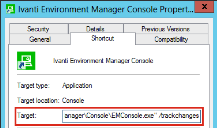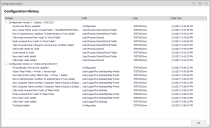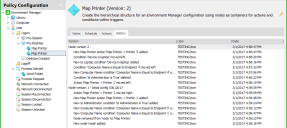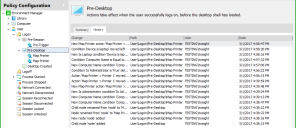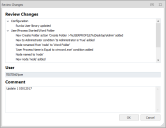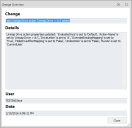This page refers to an older version of the product.View the current version of the online Help.
Configuration Change Tracking
In this section:
- About Change Tracking
- Enable and Disable Change Tracking
- Configuration History
- Node History
- Save a Configuration
- Change Overview
- Undo and Redo Changes
- Delete the Configuration History
- Export Configuration History
About
Change Tracking
When Change Tracking is enabled, Environment Manager records any activity which occurs within the configuration. The information is stored in a history.sdf file within an Environment Manager AEMP configuration file.
Configuration changes that are recorded include adding and deleting nodes, actions and conditions. Global options, such as adding to the Run As User Library and Personalization Server List, are also recorded.
Change history is available at the following levels:
- Node - Each node has its own history which lists changes to that node and any child nodes
- Trigger - All triggers include a History tab showing all nodes, actions and conditions within that trigger which have been added or changed.
- Configuration - Lists every change made to a configuration including all the node and trigger history as well as any changes to global settings and options
Enable and Disable Change Tracking
Change tracking is disabled by default for a new configuration. When a configuration is saved, so is the setting which becomes the default position.
In the Manage ribbon, select Enable Change Tracking. Once enabled, details of each change to the configuration are saved in the history and node version numbers are enabled.
When enabled, select Disable Change Tracking. When Change Tracking is disabled, the history remains but no further changes are recorded.
If you disable Change Tracking and make changes to a configuration, when re-enabled, the configuration history shows that changes have been made whilst change tracking was disabled. It will not show any details of what has changed.
Change the Default Position to Enabled
- Right-click IvantiEnvironment Manager Console from the Start menu or task bar, and select Properties.
-
In the Target field, add /trackchanges to the end of the path. Ensure there is a space between the closing quotation marks and the parameter.
The target should now read: "C:\Program Files\AppSense\Environment Manager\Console\EMConsole.exe" /trackchanges
When a new configuration is opened in the console change tracking is enabled. This does not impact saved configurations who keep the setting at the state it was saved.
Configuration History
On the Manage ribbon, select Configuration History to display details of all the changes made to a configuration whilst change tracking is enabled. Whenever a configuration is saved, a new version of the history is created outlining the changes made since the last save.
In the example below, the configuration contains history for three versions. Each version lists the changes made for that version.
The Configuration History shows the following information for each change:
- Change - An overview of the change, for example New Node Added. More detail about a change can be accessed by double-clicking any entry in the history. See Change Overview for further details.
- Path - If the change relates to a node, the path to the node is displayed. For example, User\Logon\Node A. For changes to global options and settings the path will always show Configuration.
- User - The username and, where appropriate, domain name of the user who made the change.
- Date Time - The date and time the change was made.
Changes can be sorted in ascending or descending order by clicking the column headers.
Node History
Once Change Tracking is enabled, every change made
to a node is recorded in its History tab which summarizes those changes.
When you make changes to a node, it is annotated with an asterisk to show
that there are unsaved changes within that node. Once the configuration
is saved, the asterisk is removed.
Entries are added to the history as soon as the change is made. However,
until the configuration is saved, the changes are not committed. If a
configuration is closed without saving, changes are discarded and the
history deleted.
For change tracking purposes, nodes are versioned. Each time a node is updated and the configuration is saved, a new history version of the node is created. The node history shows each version with the changes listed below.
In the example below, the configuration has been saved twice since change tracking was enabled. The node is at version two and the history displays the changes made for both versions including who made each change and when.
The history for version two shows that a child node has been created. Parent nodes only show that the child node has been added, deleted or updated. Full details of the child node can only be viewed by viewing the child node’s history. More detail about a change can be accessed by double-clicking any entry.
See Change Overview for further details.
Trigger Node History
The History tab for triggers such as Startup, Process Started and Log Off differs to that of nodes. Triggers are not versioned in the history - the history shows a continuous list of all changes made to child nodes and the trigger Environment tab since change tracking was enabled.
To help you easily identify where changes have been made, each history entry displays the configuration path for the relevant node.
Move, Copy and Import Nodes
When you cut and paste a node into another node, the version number remains unchanged and the entire node history is copied - it is the same node with the same history which has been moved. This behavior applies if a node is moved to reusable nodes.
When you copy and paste a node into another node, the version number of the copied node is set at "1" and the history only shows one entry stating where the node has been copied from. This behavior is the same if a node is cloned or copied to reusable nodes or imported as a policy template.
If copying or cutting a node from one configuration to another, the history is as if the node has been copied - the history tells you from which configuration the node originated.
Save a Configuration
When you save a configuration to disk, the Management Center, SCCM or as the live configuration on an endpoint, an overview of the changes you have made since the last save is displayed. Like node and configuration histories, more detail about a change can be viewed by double-clicking any entry in the history.
See Change Overview for further details.
You can optionally add comments which will be added to the Configuration History for that version of the configuration. Although each new version of a configuration is identified by its own version number, adding comments allows you to add your own identification.
Each time a configuration is saved, its version number is incremented and displayed at the bottom right of the console - regardless of whether change tracking is enabled or not.
Change Overview
More detailed information about each change can be accessed by double-clicking any history item from the following areas:
- Configuration History
- Node History
- Review Changes dialog when saving a configuration
In the example above, the Change field displays a high level overview - a Delete File action has been updated. This is the same text which appears in the history. The Details field shows which property has changed - the Notes for the action were updated and the Run As setting was changed, amongst other parameters.
Undo and Redo Changes
If you undo a configuration change using the buttons in the quick access menu, the history of that change removed. Similarly, if an undone change is redone, the history is restored. This applies to both configuration and node histories.

Delete the Configuration History
Change history can be deleted when required and the amount of history you delete can be defined by date or version number. You are given the option to export the history prior to deleting.
- Select the Policy Configuration navigation button.
- On the Manage ribbon, select Delete History.
- Select and configure
the history you want to delete:
- All history - Delete the entire configuration history.
- History older than date - Delete the configuration history up to the entered date.
- History up to and including selected version - Delete the configuration history up to the specified version number.
- Select whether you want to Export then Delete or just Delete.
If you export prior to the delete the selected history is exported to CSV file at a selected location.
Deleting the history does not change or remove version numbers of nodes or configurations. When the history is deleted, the version numbers stay the same and increment as normal on future saves.
Export Configuration History
Configuration History can be exported to a CSV file. You can export the whole history of the configuration since change tracking was enabled or you can choose to export the history up to a certain date or configuration version.
By creating a backup you can delete all or part of the history to reduce the configuration file size whilst ensuring that you still have access to the change tracking data. The exported history file can be opened in a spreadsheet so the data can be examined and queries run.
- Select the Policy Configuration navigation button.
- In the Manage ribbon, click Export History.
- Select and configure
the history you want to export:
- All history - Export the entire configuration history.
- History older than date - Export the configuration history up to the entered date.
- History up to and including selected version - Export the configuration history up to the specified version number.
- Click OK.
- Select a location to save the CSV file and click Save.
